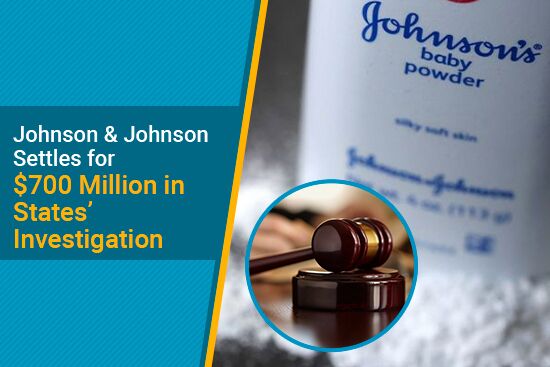Estimated Read Time: 4 minutes
UPDATE (07/01/2024); This article was updated with information on how much each state receives in the Johnson & Johnson talc cancer settlement. The amounts for each state are at the bottom of the article.
Johnson & Johnson faces nearly 60,000 pending talc cancer lawsuits from people who have used the company’s talc cosmetics during their life and later developed malignancies such as mesothelioma.
The company hopes to settle those lawsuits and avoid trials leading to multi-million-dollar verdicts, such as the $260 million verdict delivered by an Oregon jury in May.
Aside from lawsuits involving people with cancer, the company also faced an investigation from states holding Johnson & Johnson responsible for asbestos exposure through its talc cosmetics.
Earlier this month, Reuters reports that Johnson & Johnson reached a settlement with 42 states and Washington, D.C., for $700 million. The settlement ends an investigation of the company allegedly misleading consumers into believing talc products are safe. The attorneys general for Florida, North Carolina and Texas led the lawsuit.
The $700 million is to be divided among the 42 states and Washington, D.C. but not equally. For example, NBC Washington reports Virginia will receive $21.1 million while Maryland will receive $14.9 million.
The settlement includes an agreement from Johnson & Johnson to permanently stop manufacturing, promoting, and selling all products containing talcum powder. If the settlement is approved, the company will begin making payments to states in July.
Why Is Talc Dangerous?
Talc is a naturally occurring mineral. It can absorb moisture and keep skin dry and healthy. Companies like Johnson & Johnson created cosmetics and health products with talc as a foundational ingredient and sold them for decades. Johnson & Johnson Baby Powder, for example, was made with talc.
Asbestos is another naturally occurring mineral and is the only known cause of the rare cancer mesothelioma. Asbestos can also cause lung cancer and ovarian cancer.
Asbestos and talc are found in the same geographic places. When mining for talc, miners may inadvertently collect asbestos. Turning the mineral talc into a talcum powder for cosmetics can lead to asbestos contamination.
Asbestos Found in Talc Cosmetics
Several talcum powder cosmetics, including Johnson & Johnson Baby Powder, have been tested and found to contain trace amounts of asbestos.
People who used Johnson & Johnson Baby Powder on themselves, their children, or had it used on them as children have developed cancers such as mesothelioma and ovarian cancer later in life. Scientists connect their cancers to the use of this product.
Johnson & Johnson Baby Powder No Longer Sold
Johnson & Johnson Baby Powder was pulled from U.S. and Canada consumer markets in 2020. A few years later, the company stopped manufacturing and selling the product worldwide. Johnson & Johnson replaced the talc-based baby powder with a cornstarch-based baby powder.
Johnson & Johnson has attempted to settle its pending lawsuits with cancer victims. The company proposed a third bankruptcy settlement of $6.58 billion to resolve the approximately 50,000 ovarian cancer lawsuits. This proposal will not address mesothelioma lawsuits.
How Much Each State Receives in the Johnson & Johnson Settlement
USA Today published the amounts each state will receive in the Johnson & Johnson talc cancer settlement.
They are below:
- Alabama: $13.4 million
- Alaska: $3.15 million
- Arizona: $15.4 million
- Arkansas: $12.7 million
- California: $78 million
- Colorado: $14.3 million
- Connecticut: $9.2 million
- Delaware: $4.9 million
- Washington, D.C.: $3 million
- Florida: $48 million
- Georgia: $24.1 million
- Hawaii: $5.3 million
- Idaho: $5.7 million
- Illinois: $29 million
- Indiana: $18 million
- Iowa: $9.4 million
- Kansas: $11.4 million
- Kentucky: $9 million
- Maine: $4.8 million
- Maryland: $14.9 million
- Massachusetts: $14.5 million
- Michigan: $20.6 million
- Minnesota: $10.5 million
- Montana: $3.5 million
- Nebraska: $5.2 million
- Nevada: $6.1 million
- New Hampshire: $5.9 million
- New Jersey: $30.2 million
- New York: $44 million
- North Carolina: $27.3 million
- North Dakota: $3.2 million
- Ohio: $27.7 million
- Oklahoma: $9.8 million
- Oregon: $15 million
- Rhode Island: $6.9 million
- South Dakota: $3.6 million
- Texas: $61.5 million
- Utah: $7.5 million
- Vermont: $3.1 million
- Virginia: $21.1 million
- Washington: $13.9 million
- West Virginia: $5.9 million
- Wisconsin: $15.8 million
Sources & Author
- Johnson & Johnson reaches $700 million talc settlement with US states. Reuters. Retrieved from: https://www.reuters.com/legal/new-york-sues-johnson-johnson-2024-06-11/. Accessed: 06/14/2024.
- Here’s how much each state will receive from the $700 million Johnson & Johnson settlement. USA Today. Retrieved from: https://www.usatoday.com/story/money/2024/06/12/j-and-j-baby-powder-settlement/74070086007/. Accessed: 07/01/2024.
- Johnson & Johnson, 43 attorneys general reach $700M settlement over talc baby powder. NBC Washington. Retrieved from: https://www.nbcwashington.com/news/local/johnson-johnson-42-attorneys-general-reach-700m-settlement-in-talc-baby-powder-investigation/3638879/. Accessed: 06/14/2024.
About the Writer, Devin Golden
Devin Golden is the senior content writer for Mesothelioma Guide. He produces mesothelioma-related content on various mediums, including the Mesothelioma Guide website and social media channels. Devin's objective is to translate complex information regarding mesothelioma into informative, easily absorbable content to help patients and their loved ones.
Sources & Author
About the Writer, Devin Golden
Devin Golden is a content writer for Mesothelioma Guide. He produces mesothelioma-related content on various mediums, including the Mesothelioma Guide website and social media channels. Devin's objective is to translate complex information regarding mesothelioma into informative, easily absorbable content to help patients and their loved ones.
